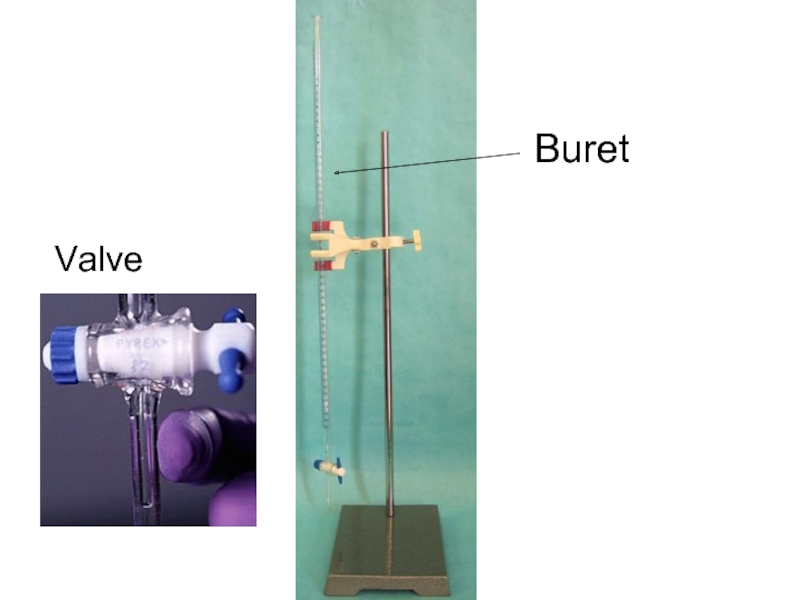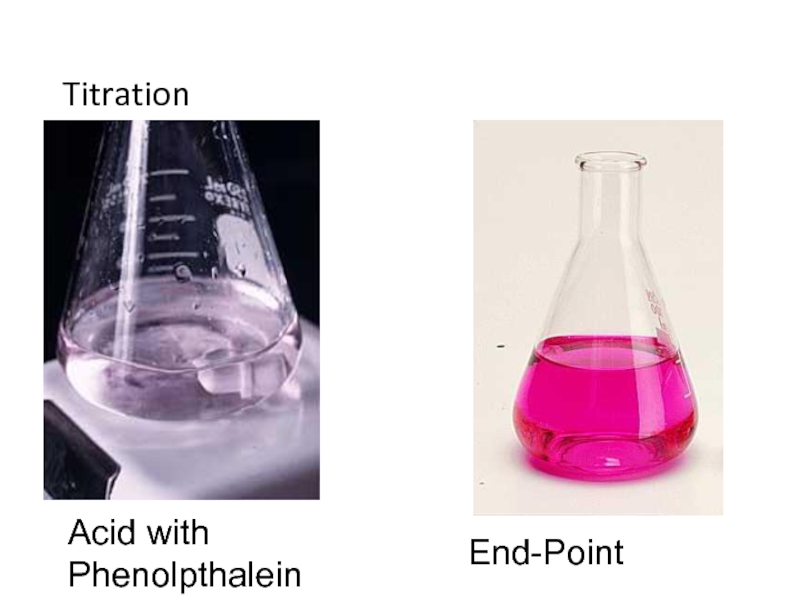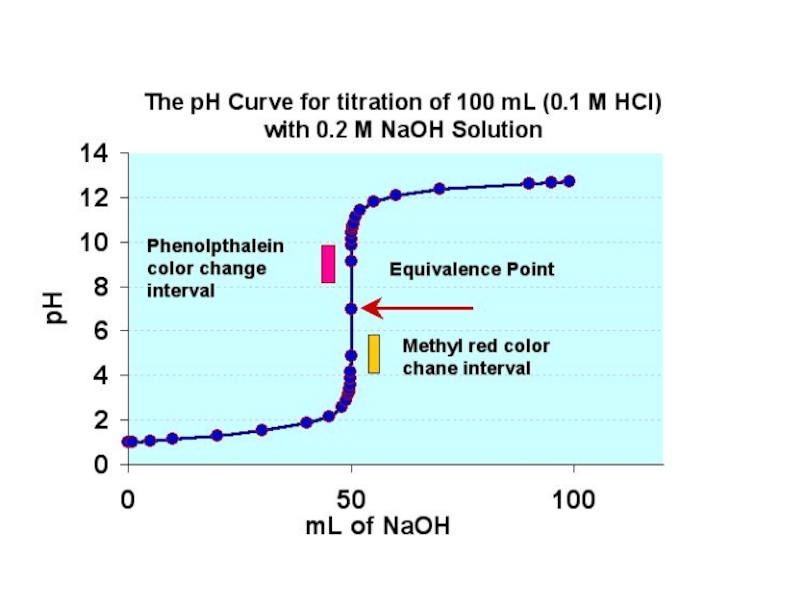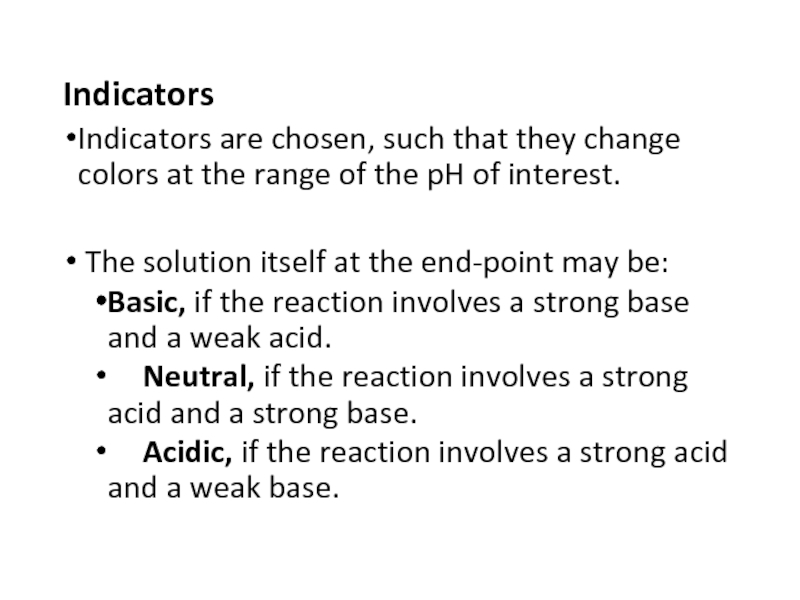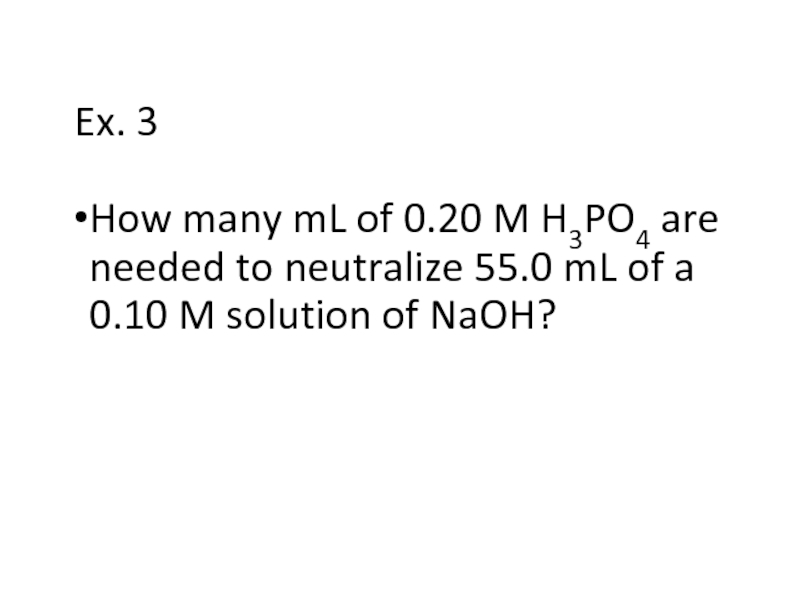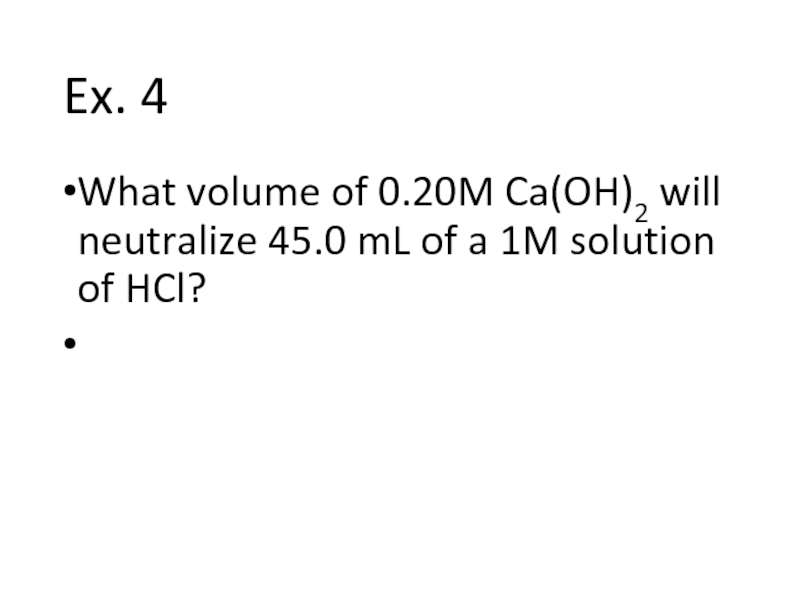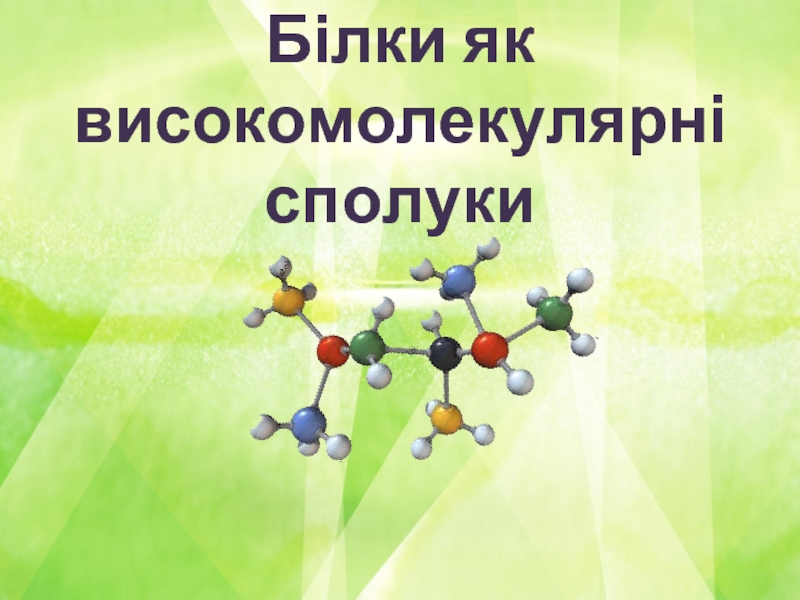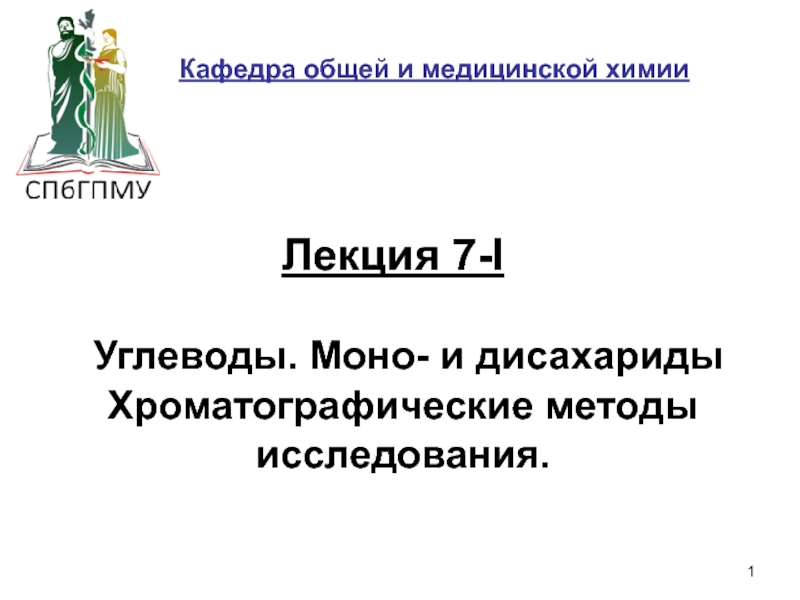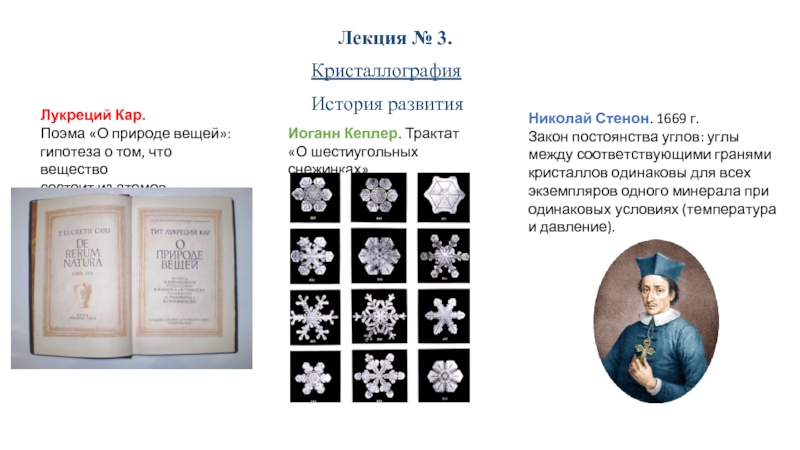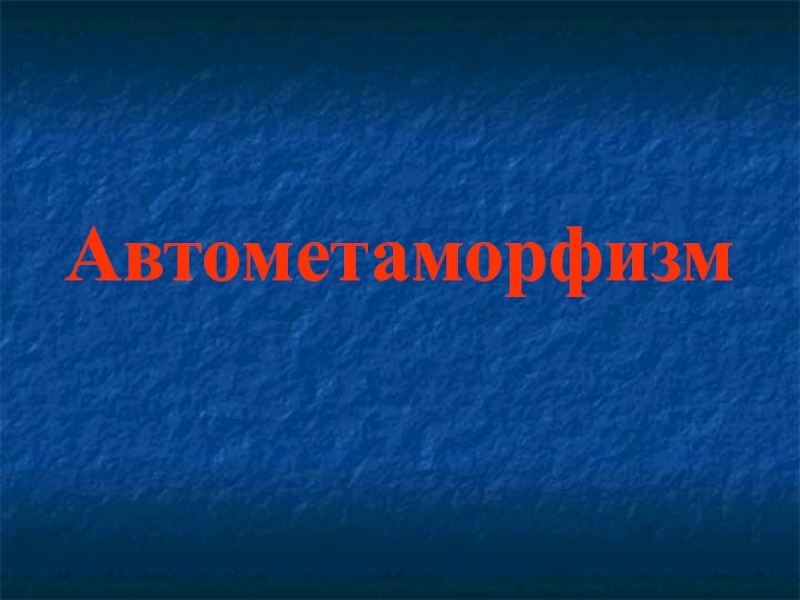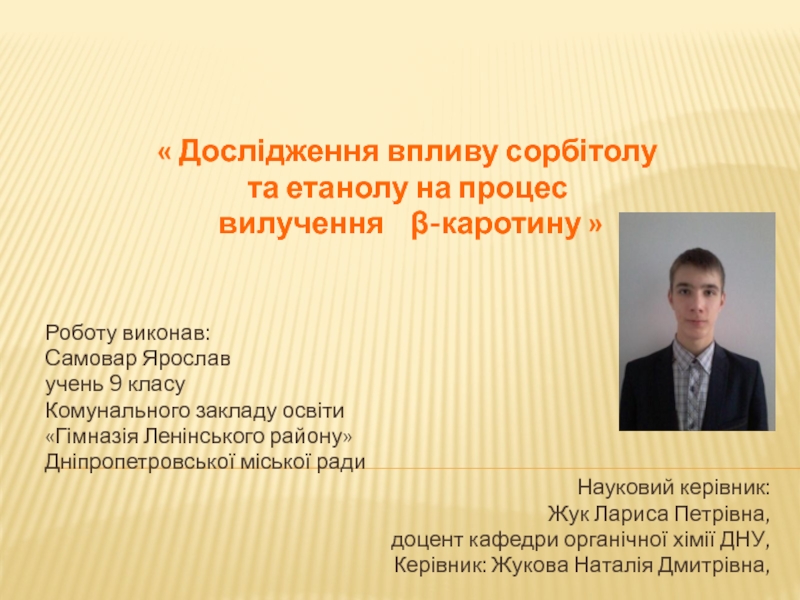- Главная
- Разное
- Дизайн
- Бизнес и предпринимательство
- Аналитика
- Образование
- Развлечения
- Красота и здоровье
- Финансы
- Государство
- Путешествия
- Спорт
- Недвижимость
- Армия
- Графика
- Культурология
- Еда и кулинария
- Лингвистика
- Английский язык
- Астрономия
- Алгебра
- Биология
- География
- Детские презентации
- Информатика
- История
- Литература
- Маркетинг
- Математика
- Медицина
- Менеджмент
- Музыка
- МХК
- Немецкий язык
- ОБЖ
- Обществознание
- Окружающий мир
- Педагогика
- Русский язык
- Технология
- Физика
- Философия
- Химия
- Шаблоны, картинки для презентаций
- Экология
- Экономика
- Юриспруденция
Titration and Acid-Base Neutralization презентация
Содержание
- 1. Titration and Acid-Base Neutralization
- 2. LEARNING OBJECTIVES 11.2.2.7 understand the purpose
- 3. The Titration One of the most important
- 4. Acid-Base Titration Terms to Know Titrant: the
- 5. Types of Acid-Base Titrations The quality of
- 6. Strong Acid-Strong Base This diagram shows the
- 7. Strong Base-Strong Acid Strong base-strong acid titrations
- 8. Titration Equipment Stand Buret Buret clamp Erlenmeyer
- 9. Preparing the Titration Make sure your equipment
- 10. Starting the Titration Turn the stirrer onto
- 11. Around the Endpoint You have reached the
- 12. Acid Base Neutralization Reaction Acid
- 13. Example: Stomach antacids
- 14. Titration: A laboratory method for determining the
- 15. Equivalence Point The point at which there
- 16. Buret Valve
- 17. Titration Acid with Phenolpthalein End-Point
- 19. Indicators Indicators are chosen, such that they
- 20. Methods of Solving Titration Problems: a)
- 21. Ex. 1 What is the concentration
- 22. Ex. 2 A 20.0 mL solution of
- 23. Ex. 3 How many mL of 0.20
- 24. Ex. 4 What volume of 0.20M Ca(OH)2
Слайд 2LEARNING OBJECTIVES
11.2.2.7 understand the purpose of, be able to carry out,
and be able to carry out calculations involving, titration
Слайд 3The Titration
One of the most important lab procedures involving acids and
bases is the titration.
A titration is an analytical procedure that allows for the measurement of the amount of one solution that is required to exactly react with the contents of another solution.
In acid-base terms, you add one solution to the other until the equivalence point is reached.
The use of a pH meter will produce a pH curve (titration curve), so you can specifically calculate at what pH your solutions have been neutralized.
A titration is an analytical procedure that allows for the measurement of the amount of one solution that is required to exactly react with the contents of another solution.
In acid-base terms, you add one solution to the other until the equivalence point is reached.
The use of a pH meter will produce a pH curve (titration curve), so you can specifically calculate at what pH your solutions have been neutralized.
Слайд 4Acid-Base Titration Terms to Know
Titrant: the standard solution of known molarity
in the buret that is being added to the solution in the flask. This is more often the acid than the base.
Analyte: the solution in the flask of unknown concentration. Usually the base.
Indicator: a compound that is added in small amounts (a few drops) in acid-base titrations. It changes color over a certain pH range, and indicates the end of the titration. This range should be matched with pH at which you expect your solutions to reach the equivalence point.
Endpoint: the point at which the titration is stopped, when the indicator permanently changes color. Traditionally, this is the point when the titration is stopped, where the number of moles of titrant is equal to the number of moles of analyte, or some multiple thereof (as in di- or tri- protic acids)
Equivalence point (a.k.a. neutralization or endpoint): the point (in mL of solution added) at which the number of moles of acid equal the number of moles of base.
Analyte: the solution in the flask of unknown concentration. Usually the base.
Indicator: a compound that is added in small amounts (a few drops) in acid-base titrations. It changes color over a certain pH range, and indicates the end of the titration. This range should be matched with pH at which you expect your solutions to reach the equivalence point.
Endpoint: the point at which the titration is stopped, when the indicator permanently changes color. Traditionally, this is the point when the titration is stopped, where the number of moles of titrant is equal to the number of moles of analyte, or some multiple thereof (as in di- or tri- protic acids)
Equivalence point (a.k.a. neutralization or endpoint): the point (in mL of solution added) at which the number of moles of acid equal the number of moles of base.
Слайд 5Types of Acid-Base Titrations
The quality of the titration depends on the
strength of the acids and bases you use. This, in turn, will affect the resulting pH curve.
Let’s look at a few examples of pH curves.
Let’s look at a few examples of pH curves.
Слайд 6Strong Acid-Strong Base
This diagram shows the change in pH as a
solution of strong acid is slowly added to a solution of strong base.
Strong acid-strong base titrations usually have an equivalence point around 7.
This is due to the fact that in solution, strong acids and strong bases will both completely dissociate, so there is an approximate 1:1 ratio of moles of acid to moles of base at the equivalence point.
Strong acid-strong base titrations usually have an equivalence point around 7.
This is due to the fact that in solution, strong acids and strong bases will both completely dissociate, so there is an approximate 1:1 ratio of moles of acid to moles of base at the equivalence point.
Слайд 7Strong Base-Strong Acid
Strong base-strong acid titrations are just like the strong
acid-strong base titrations: the pH at the equivalence point is around 7
Note that in both types, there is relatively little change in pH until it jumps steeply at the equivalence point.
Note that in both types, there is relatively little change in pH until it jumps steeply at the equivalence point.
Слайд 8Titration Equipment
Stand
Buret
Buret clamp
Erlenmeyer Flask (diagram shows a beaker)
Analyte (unknown molarity)
Titrant (standard
solution of known molarity)
Indicator
pH meter (optional, but highly recommended)
Stirrer (optional, recommended)
Indicator
pH meter (optional, but highly recommended)
Stirrer (optional, recommended)
Слайд 9Preparing the Titration
Make sure your equipment is clean!
Take care when preparing
the buret. Run distilled water through it to make sure it is clean. Then, rinse it with some of the titrant solution, letting it run through to stopcock as well. This will ensure that there is no water left, so that the concentration of the titrant is not unexpectedly diluted when you actually perform the titration.
Measure out the volume of the analyte that you add to the flask, and record it. Add a few drops of an appropriate indicator. Set the flask on the stirrer and the magnet inside in flask.
Fill the buret with an appropriate amount of titrant, and record this initial amount. Secure the buret to the stand over the flask with a clamp.
Put the pH meter in the flask, and secure it with a clamp.
Measure out the volume of the analyte that you add to the flask, and record it. Add a few drops of an appropriate indicator. Set the flask on the stirrer and the magnet inside in flask.
Fill the buret with an appropriate amount of titrant, and record this initial amount. Secure the buret to the stand over the flask with a clamp.
Put the pH meter in the flask, and secure it with a clamp.
Слайд 10Starting the Titration
Turn the stirrer onto a low setting.
Add a few
milliliters of titrant to the analyte at a time by switching the stopcock between the open and closed positions, and record the pH every few milliliters added.
As the titrant is dropped into the analyte, the indicator will briefly change color, and then disappear.
The initial changes in pH will be very small, since all of the added titrant will be reacted by the excess analyte
As the titrant is dropped into the analyte, the indicator will briefly change color, and then disappear.
The initial changes in pH will be very small, since all of the added titrant will be reacted by the excess analyte
Слайд 11Around the Endpoint
You have reached the endpoint when the indicator first
permanently changes color.
There will be a very large jump in pH as all of the analyte is reacted, and there is now excess titrant.
There will be a very large jump in pH as all of the analyte is reacted, and there is now excess titrant.
Example of a solution using phenolphthalein as a indicator. The reaction has just reached the equivalence point, because the solution has just permanently turned pale pink.
Слайд 14Titration:
A laboratory method for determining the concentration of an unknown acid
or base using a neutralization reaction.
A standard solution,(a solution of known concentration), is used.
A standard solution,(a solution of known concentration), is used.
Слайд 15Equivalence Point
The point at which there are stoichiometrically equivalent amounts of
acid and base.
[H+] = [OH-]
[H+] = [OH-]
Слайд 19Indicators
Indicators are chosen, such that they change colors at the range
of the pH of interest.
The solution itself at the end-point may be:
Basic, if the reaction involves a strong base and a weak acid.
Neutral, if the reaction involves a strong acid and a strong base.
Acidic, if the reaction involves a strong acid and a weak base.
The solution itself at the end-point may be:
Basic, if the reaction involves a strong base and a weak acid.
Neutral, if the reaction involves a strong acid and a strong base.
Acidic, if the reaction involves a strong acid and a weak base.
Слайд 20Methods of Solving Titration Problems:
a) using stoichiometry
b) using the titration formula
aMaVa=bMbVb.
Слайд 21Ex. 1
What is the concentration of HCl if 30.0 mL
of 0.10 M NaOH neutralizes 50.0mL HCl?
NaOH + HCl → H2O + NaCl
Hint: Use aMaVa=bMbVb
Ma=
How many moles of HCl were used?
Hint: #moles= MaVa , but convert the volume to L( 50mL=0.05L).
NaOH + HCl → H2O + NaCl
Hint: Use aMaVa=bMbVb
Ma=
How many moles of HCl were used?
Hint: #moles= MaVa , but convert the volume to L( 50mL=0.05L).
Слайд 22Ex. 2
A 20.0 mL solution of Sr(OH)2 is neutralized after 25.0
mL of standard 0.05 M HCl is added. What is the concentration of Sr(OH)2?
2 HCl + Sr(OH)2 → 2 H2O + SrCl2
2 HCl + Sr(OH)2 → 2 H2O + SrCl2
Слайд 23Ex. 3
How many mL of 0.20 M H3PO4 are needed to
neutralize 55.0 mL of a 0.10 M solution of NaOH?
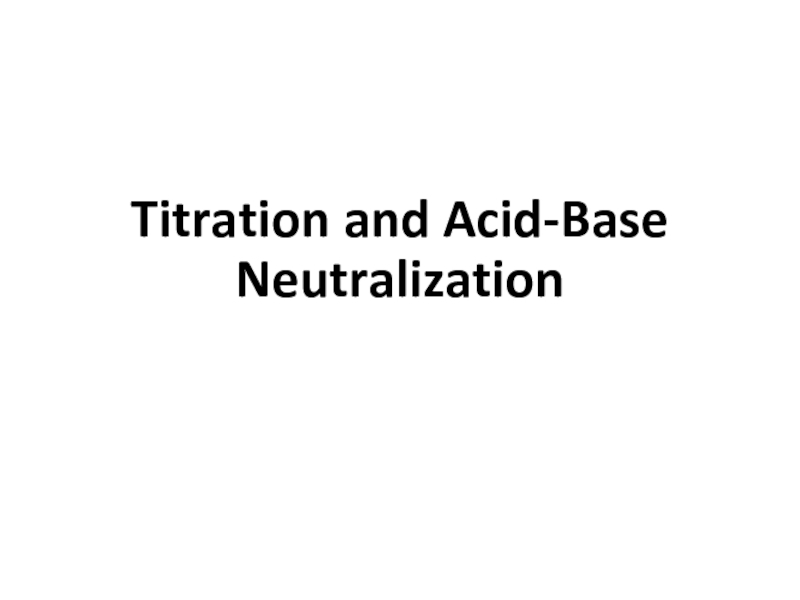
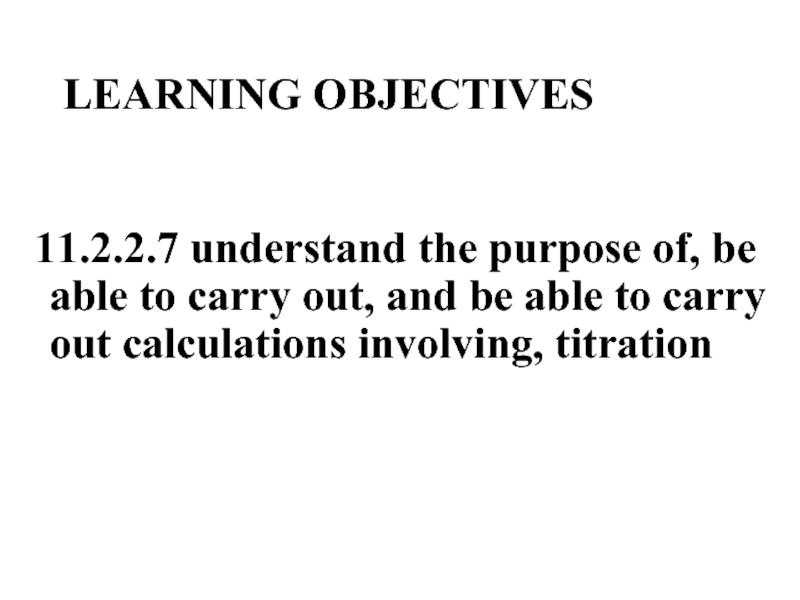
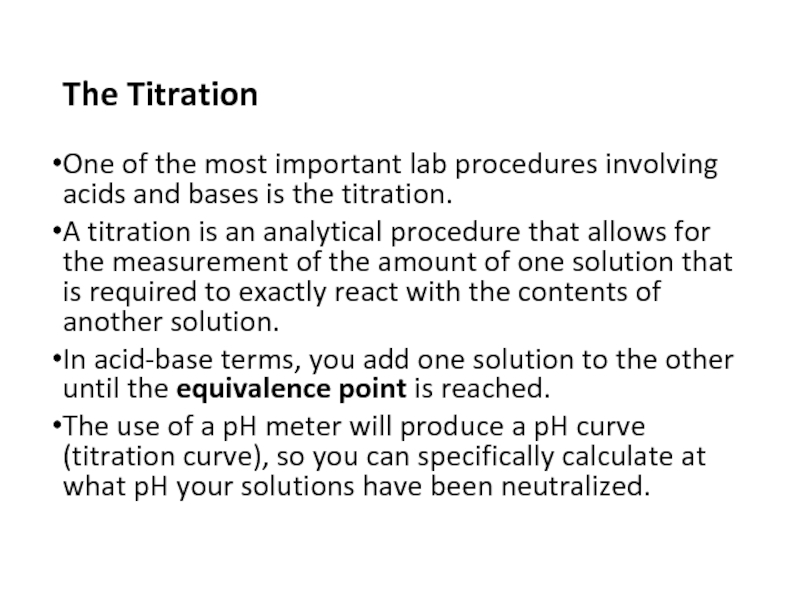
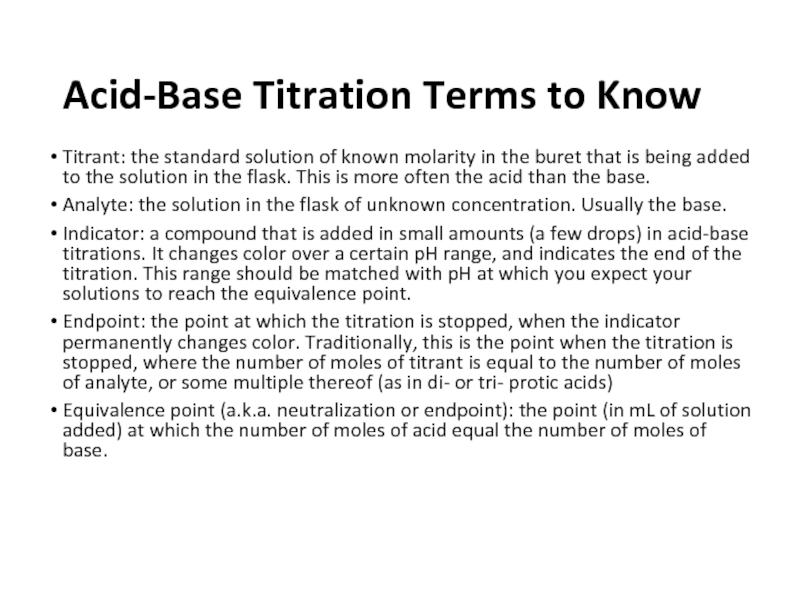
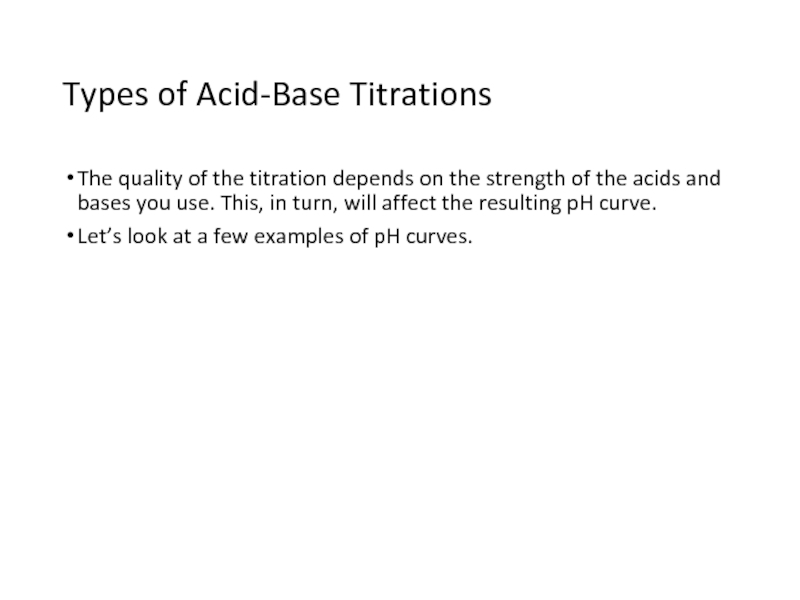
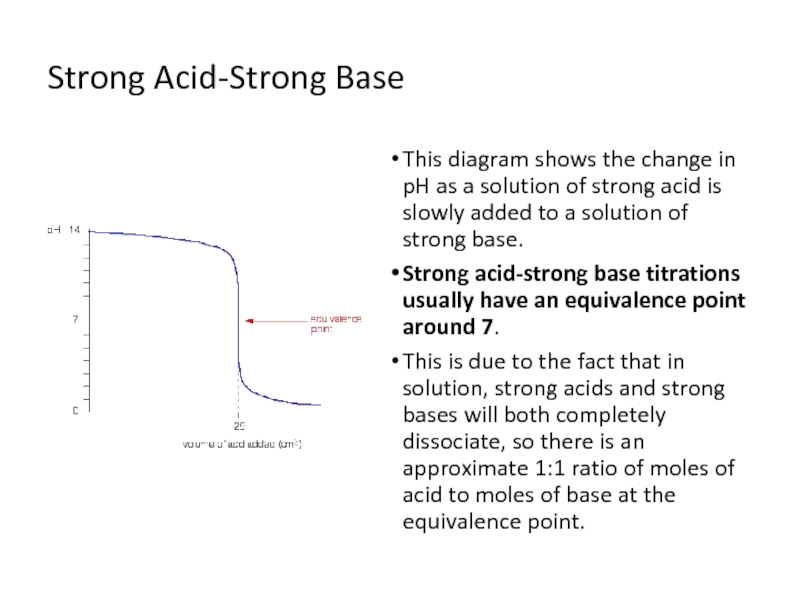
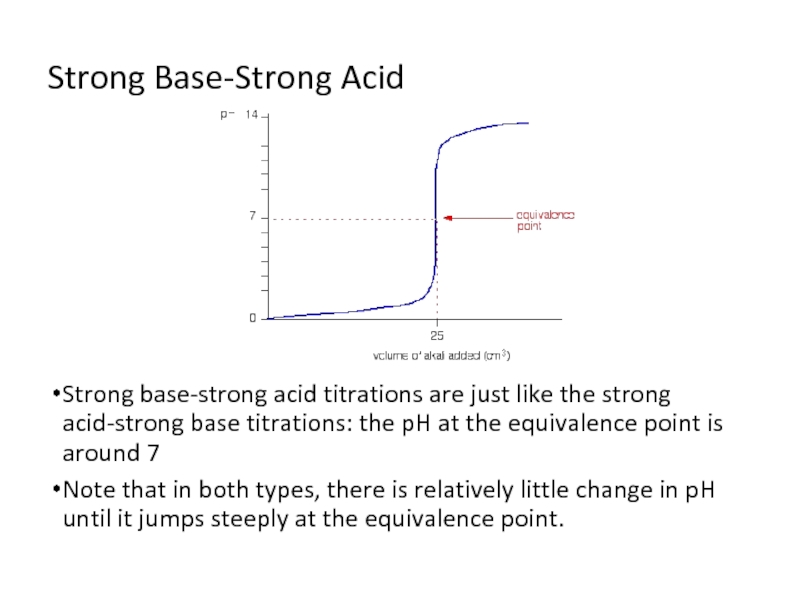

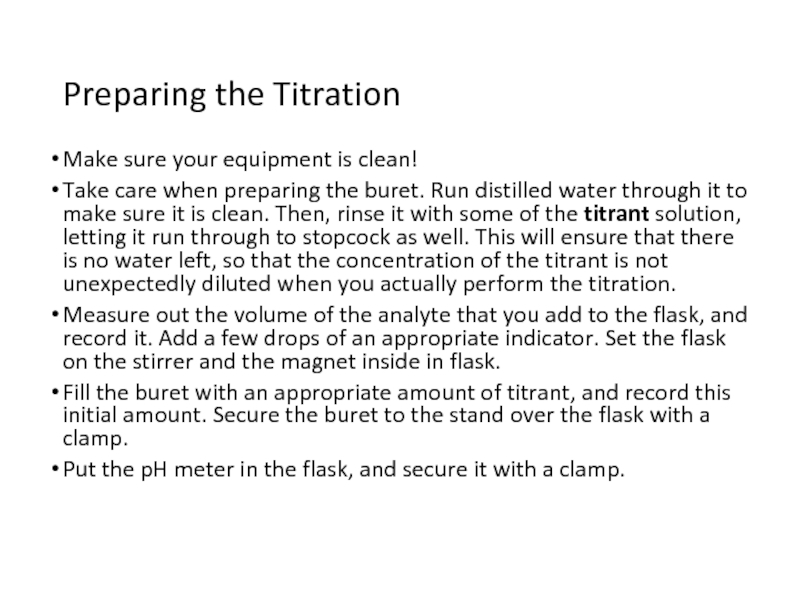
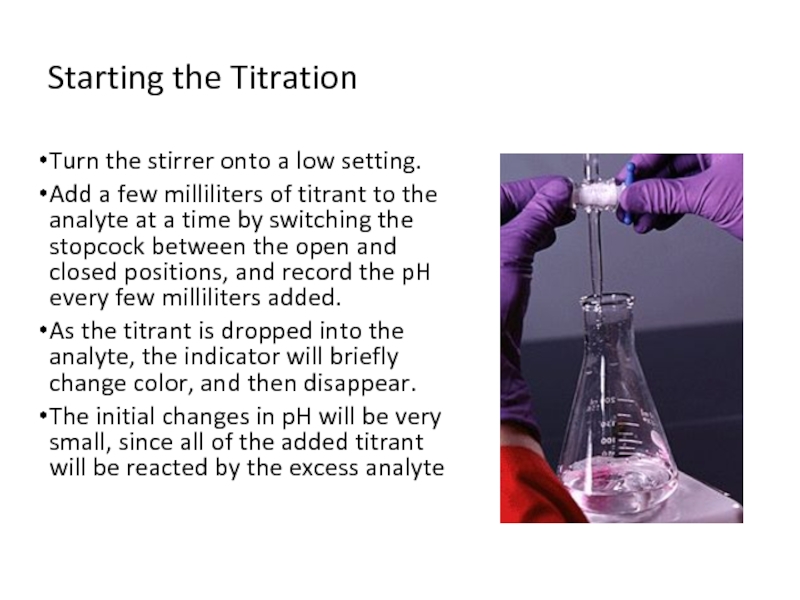
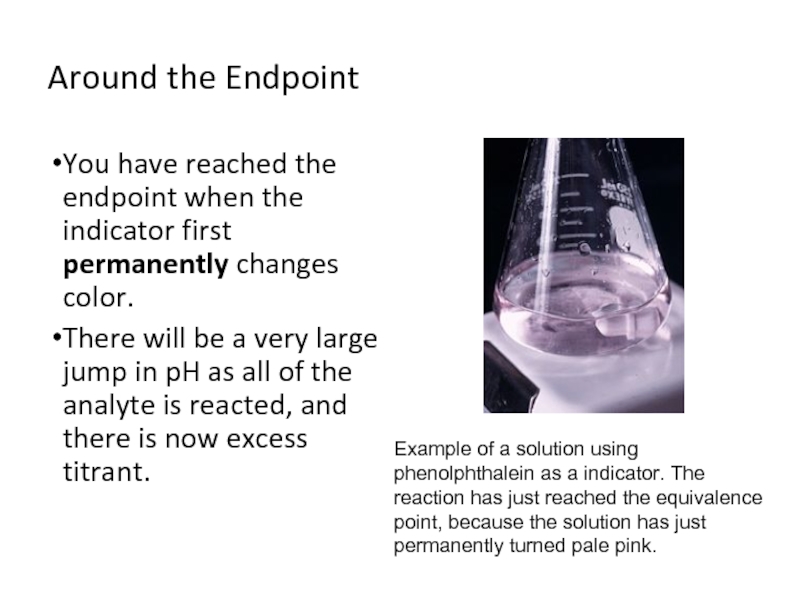
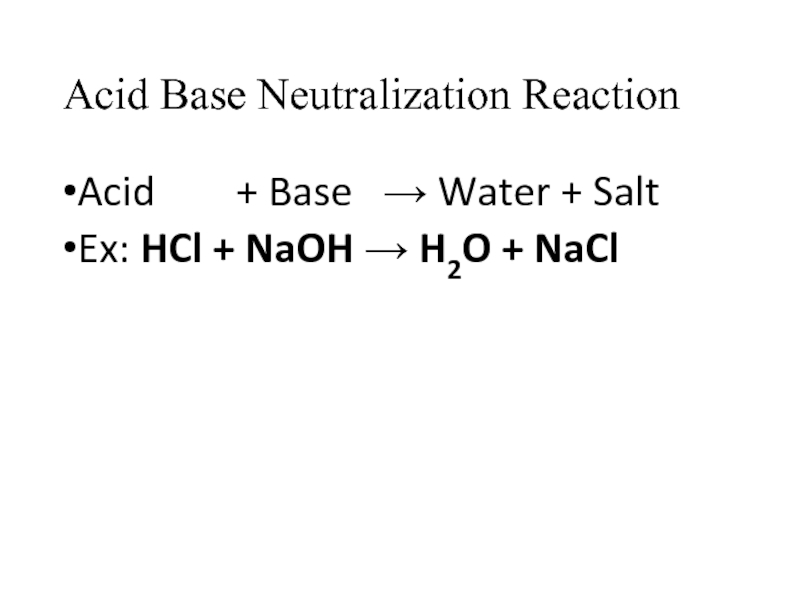
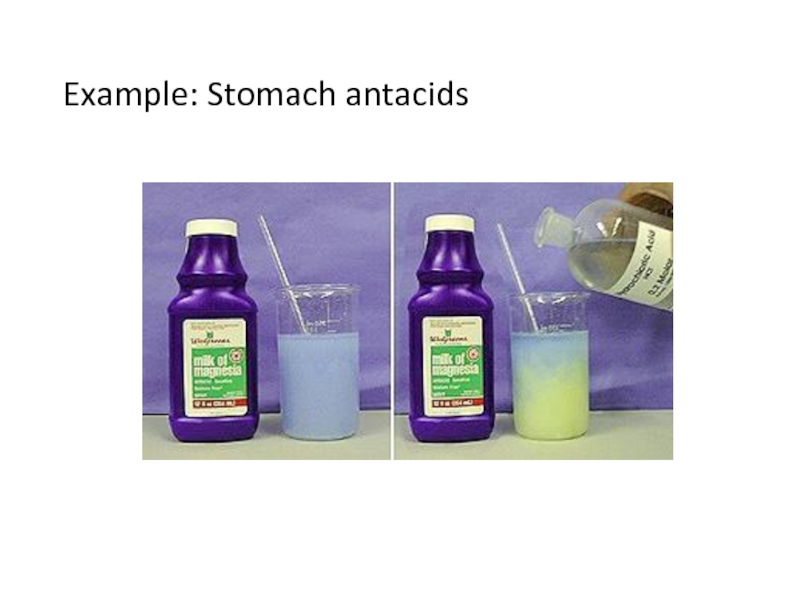
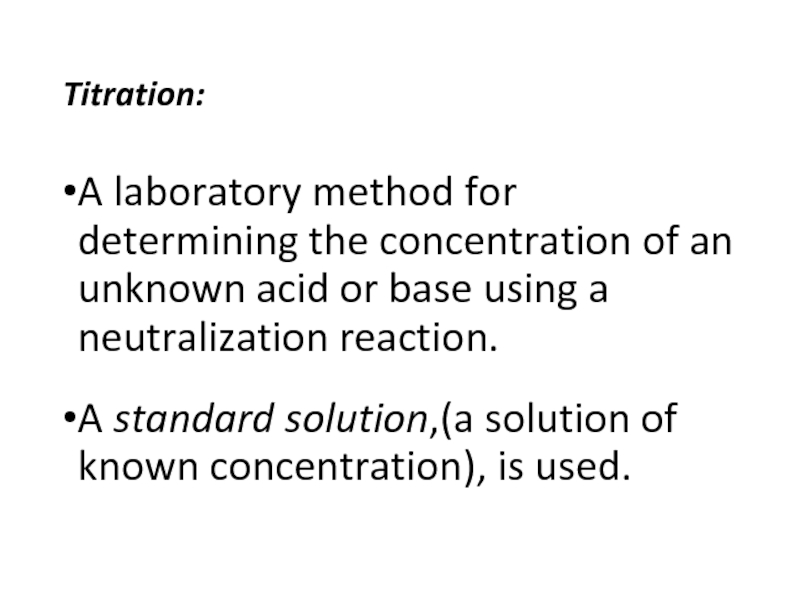
![Equivalence PointThe point at which there are stoichiometrically equivalent amounts of acid and base. [H+]](/img/tmb/3/213206/3b33b3fca284aeb3b9b6f5da2a672498-800x.jpg)
